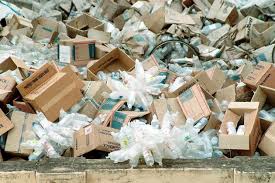Bio-medical Waste
Introduction:
In order to clean the waste in their surroundings they pick it up and throw it. What if the waste you touch is hazardous or radioactive? Yes it can be true, I am talking about bio-medical waste which can be both and can harm you in many ways.
‘Bio-medical waste’ means “Any waste generated during diagnosis, treatment or immunization of human beings or animals”. Biomedical waste is something that you can easily found in your surroundings. Biomedical waste can be categorized based on the risk of causing injury and/or infection during handling and disposal. Wastes targeted for precautions during handling and disposal include sharps (needles or scalpel blades), pathological wastes (anatomical body parts, microbiology cultures and blood samples) and infectious wastes (items contaminated with body fluids and discharges such as dressing, catheters and I.V. lines). Other wastes generated in healthcare settings include radioactive wastes, mercury containing instruments and polyvinyl chloride (PVC) plastics. These are among the most environmentally sensitive by-products of healthcare. WHO stated that 85% of hospital wastes are actually non-hazardous, around 10% are infectious and around 5% are non-infectious but hazardous wastes. In the USA, about 15% of hospital waste is regulated as infectious waste. In India this could range from 15% to 35% depending on the total amount of waste generated. The management of bio-medical waste is still in its infancy all over the world. There is a lot of confusion with the problems among the generators, operators, decision-makers and the general community about the safe management of bio-medical waste. The reason may be a lack of awareness. Hence resource material on the environment for hospital administrators, surgeons, doctors, nurses, paramedical staff and waste retrievers, is the need of the hour.
BODY:
The improper management in bio-medical waste causes stern environmental problems that causes to air, water and land pollution. The pollutants that cause damage can be classified into biological, chemical and radioactive. There are several legislations and guidelines in India concerning environmental problems, which can be addressed.
Air pollution can be caused in both indoors and outdoors atmosphere. Biomedical waste that generated by air pollution are been classified in three types namely-Biological, Chemical and radioactive.
In-door air pollution Pathogens present in the waste can enter and remain in the air for a long period in the form of spores or as pathogens Segregation of waste, pre-treatment at source etc., can also reduce this problem to a great extent. Sterilizing the rooms will also help in checking the indoor air pollution due to biological. The indoor air pollution caused due to the chemicals from poor ventilation can cause diseases like Sick Building Syndrome (SBS). Proper building design and well-maintained air conditioners can reduce the SBS. Chemicals should be utilized as per prescribed norms. Over use of chemicals should be avoided.
Outdoor air pollution can be caused by pathogens. The biomedical waste without pre-treatment if transported outside the institution, or if it is dumped in open areas, pathogens can enter into the atmosphere. Chemical pollutants that cause outdoor air pollution have two major sources-open burning and incinerators. Open burning of bio-medical waste is the most harmful practice. When inhaled can cause respiratory diseases. Certain organic gases such as dioxins and furans are carcinogenic. The design parameters and maintenance of such treatment and disposal technology should be as per the prescribed standards.
Radioactive emissions Research and radio-immunoassay activities may generate small quantities of radioactive gas. Gaseous radioactive material should be evacuated directly to the outside. The use of such device requires maintenance of the trap and monitoring of the off-gas.
Water Pollution The liquid waste generated when let into sewers can also lead to water pollution if not treated properly. Water pollution can alter parameters such as pH, BOD, DO, COD, etc. There are instances where dioxins are reported from water bodies near incinerator plants. Dioxins enter the water body from the air.
Radioactive waste in liquid form can come from chemical or biological research, from body organ imaging, from decontamination of radioactive spills, from patient’s urine and from scintillation liquids used in radioimmunoassay. Under normal circumstances, urine and faeces can be handled as no radioactive waste so long as the patient’s room is routinely monitored for radioactive contamination.
Land Pollution Soil pollution from bio-medical waste is caused due to infectious waste, discarded medicines, chemicals used in treatment and ash and other waste generated during treatment processes. Heavy metals such as cadmium, lead, mercury etc., which are present in the waste will get absorbed by plants and can then enter the food chain. Nitrates and phosphates present in leachates from landfills are also pollutants. Excessive amounts of trace nutrient elements and other elements including heavy metals in soil are harmful to crops and are also harmful to animals and human beings.
Health hazards According to the WHO, the global life expectancy is increasing year after year. However, deaths due to infectious disease are increasing. A study conducted by the WHO in 1996, reveals that more than 50,000 people die everyday from infectious diseases. One of major causes for the increase in infectious diseases is improper waste management. List of infections and diseases documented to have spread through bio-medical waste. Tuberculosis, pneumonia, diarrhea , tetanus, whooping cough etc., are other common diseases spread due to improper waste management.
Occupational health concerns exist for janitorial and laundry workers, nurses, emergency medical personnel, and refuse workers. Injuries from sharps and exposure to harmful chemical waste and radioactive waste also cause health hazards to employees in institutions generating bio-medical waste. Proper management of waste can solve the problem of occupational hazards to a large extent.
The general public’s health can also be adversely affected by bio-medical waste. Improper practices such as dumping of bio-medical waste in municipal dustbins, open spaces, water bodies etc., leads to the spread of diseases. Emissions from incinerators and open burning also lead to exposure to harmful gases which can cause cancer and respiratory diseases. Plastic waste can choke animals, which scavenge on openly dumped waste. Injuries from sharps are common feature-affecting animals. Harmful chemicals such as dioxins and furans can cause serious health hazards to animals and birds. Certain heavy metals can affect the reproductive health of the animals.
The Environment Protection Act, 1986
This act made various rules and guidelines under sections 6, 8 & 25. Based on this the Biomedical wastes (management & handling) Rules, 1998 was formulated. Of this, Sec. 3: Facilitates Government authority to undertake various steps for protection and improvement of environment Sec. 5: Provides for issuance of direction in writing Sec. 6: empowers the governments to make rules Sec. 8: Education of individuals dealing with hazardous waste regarding safety measures Sec. 10: Permits authorities to enter the premises and inspect
Sec. 15: Government can take steps against defaulters Sec. 17: Punishment in case of violations by government departments
Biomedical waste (Management & Handling) Rules 1998
In accordance with this rules, it is the duty of every “occupier” i.e., a personwho has the control over the institution or its premises, to take all steps to ensure that waste generated is handled without any adverse effect to human health and environment. The hospitals have to set up their own facilities within the time frame (Schedule VI) or ensure the medical waste treatment at a common waste treatment facility.
The state governments shall require establishing a prescribed authority for this purpose.
The objectives and rationale of BMW management are mainly to reduce waste generation, efficient collection, handling and disposal in such a way that it controls infection and provides safety for employees working in the system and ensure cost effectiveness by avoiding penalties and fines imposed by regulatory authorities. Accordingly, waste is required to be treated and disposed of in accordance with schedules prescribed. The essentiality is to recognize the waste, identify where waste is generated and determine the reason of generation, and final plan disposal of the waste in a scientific manner so as to render it environmentally non-hazardous and eliminate the source of infection.
Conclusion:
Proper management of Bio medical waste is a concern that has been recognized by both government agencies and the Non government organizations. Several hazards and toxic materials containing should be disposed off with proper take and care. Inadequate and inefficient segregation and transportation system may cause severe problem to the society hence implementing of protective measures, written policies all of these factors contribute to increased risk of exposure of staff, patients and the community to biomedical hazards. In order to accelerate the rate at which proper processing and management methods are designed, timely regulatory and legislative policies and procedures are needed. To properly separate, process and isolation of wastes, they must be well-characterized, which is challenging. Safe and effective management of bio medical waste is not only a legal necessity but also a social responsibility. Lack of concern in persons working in that area, less motivation, awareness and cost factor are some of the problems faced in the proper hospital waste management. Proper surveys of waste management procedures in various practices are needed. Clearly there is a need for education as to the hazards associated with improper waste disposal. An effective communication strategy is imperative keeping in view the low awareness level among different category of staff in the health care establishments regarding biomedical waste management. One important direction for future research would be to project the flows of bio medical waste worldwide and quantitatively and qualitatively assess.
Click here for government certification in Energy





20 Comments. Leave new
Since I am from chemical engineering field I can easily understand the problems and hazards that bio-medical waste can cause. Awareness regarding this is very much necessary..So, I would say a good topic choosen and very well described too.
Thank You. Appreciate for feedback.
Quite an effort !! Well described..
Awakening!! really a serious concern for the future!
very well done. superb article.
I must appreciate! What a great eddort to write such an article! Good work and quite informative too 🙂
Well explained.
Nice topic! Very well explained 🙂
Great effort. Thoroughly explained.
informative and u have explained it very well.
good effort!
U choose s very good topic and described it properly!!
Good efforts …
good job!
Thank you all for your feedbacks.. 🙂
Useful to read your article. Well done.
Worth reading☺
Bio medical waste is aa serious concern :/ for the future
Good work by puttig light on it 😀
More awareness needs to be spread about bio medical wastes….good job in increasing the awareness
Well elaborated.. Learnt something new today .. Thanks!
Well articulated!